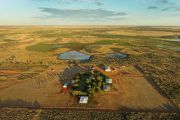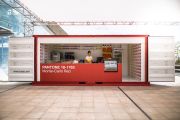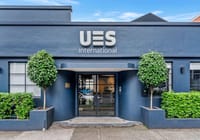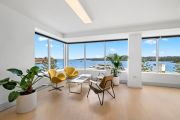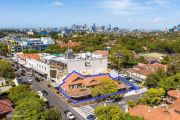
Why co-working operators love the weak office market
High office vacancy rates – especially in Melbourne – and risk-averse tenants wary of signing long-term leases are providing the impetus for the next growth phase for Australia’s rebounding co-working and flexible office sector.
Having weathered the pandemic and bankruptcy of global operator WeWork, well-established local operators like CreativeCubes and Waterman Workspaces are embarking on big expansion programs this year. At the same time, US real estate giant Pembroke is launching its first flexible office hub in the historic T&G building on Melbourne’s Collins Street.

Taking up almost all of level two at 161 Collins Street, the roughly 3000-square-metre “&Co” hub is more than 90 per cent occupied ahead of its official launch at the end of January. Brands including Christian Dior, global artificial intelligence company Databricks and luxury watch reseller Rexer & Co are among those moving in.
The space was previously leased to another co-working hub operator Spaces (part of global office space firm IWG) but when it closed shop last year, Pembroke regional director Joe Fitzpatrick saw an opportunity to deliver something in keeping with the prestige of the building and its big-name office tenants (which include Accenture, Google and Treasury Wine Estates).
“Launching our own flexible working brand is something we have bounced around for quite a few years,” Mr Fitzpatrick told The Australian Financial Review.
“Pre-COVID, when there were sub-5 per vacancy rates, no one had the luxury of the space to give the idea a chance.
“When you are in a market with circa 20 per cent vacancy it’s not like there is a line of traditional leases to take this [vacant space] on.”
Having spruced up the former Spaces tenancy to give it a more sophisticated, corporate feel in keeping with the building’s heritage status and premier location at the chic “Paris end” of Collins Street, demand has exceeded expectations.
“We’ve been doing six deals a month,” Mr Fitzpatrick said.
Time is right
It’s an opportune time for co-working operators to stake out space.
The traditional office sector continues to struggle, with higher vacancy rates pulling asset values lower. Office cap or capitalisation rates – akin to yields – have risen 75 basis points this financial year to date as values have fallen, well above the 20-basis-point expansion in industrial property and 6-basis-point expansion in retail, Citi analysts said last week.
But there are also early signs of an upturn in the sector. Mirvac Wholesale Office Fund, Lendlease Prime Property Fund and ISPT’s 50 Lonsdale Street Trust delivered positive returns during the three months to December, the first time since March 2023 that an office fund with more than one asset experienced capital growth, according to the MSCI/Mercer Australia Core Wholesale Monthly Property Fund Index.
Mr Fitzpatrick said the leasing success came from the same strategies it used to turn around assets like 161 Collins Street, which Pembroke purchased at the end of 2015 for $275 million and extensively refurbished. That project brought in not just blue-chip office tenants but created a luxury retail precinct at its base including the likes of Versace, Armani and Gucci.
“Attention to detail regarding customer service has been key. We don’t need gadgets [like other hubs],” Mr Fitzpatrick said.
To ensure it delivered the right offering – the hub has the look and feel of a luxury hotel lobby – he said it was important for Pembroke to operate the hub itself under its brand.
“We wanted control of the brand. We can’t have mismanagement of this asset affect the overall building.”
Special – and flexible
Geoff Chin, co-founder of luxury watch reseller Rexer & Co, said the co-working hub’s location, surrounding amenity and luxury offerings were big drawcards. But, he said the key attraction was knowing the business could grow into a larger space in three, six or 12 months “without being locked into a long-term lease”.
Reticence around committing to traditional office leases is also driving up demand at CreativeCubes, one of Melbourne’s largest co-working operators, majority owned by Flight Centre co-founder and former Rich Lister Geoff Harris.
CreativeCubes opened a hub in East Melbourne near the MCG in August, and occupancy is 60 per cent already, said founder and CEO Tobi Skovron.
CreativeCubes, which last year acquired five Victorian sites from corporate-focused brand Workspace365, will open four more hubs this year (including its first in Sydney and two in Adelaide) to take its network to 15.
Landlords were coming to CreativeCubes saying they needed to make their assets relevant again, he said.
“They want to be able to attract someone who doesn’t want to take a 20,000-square-metre long-term lease,” Mr Skovron said. “We’re getting a lot of calls from landlords who want to partner with us across multiple properties they own.”
Another Melbourne-based operator, Waterman Workspaces, is on track to grow to 30,000 square metres of leased space as it caters for growing demand.
In the first half of the year, it will open four new suburban centres including in South Yarra, Blackburn North and Merrifield, and another three more in the second half of the year, including its first in the Melbourne CBD at 260 Collins Street.
Waterman has several hubs within major shopping centre precincts, including at Chadstone, the country’s largest mall.
Peter Tainsh, project director at Waterman, said many Chadstone users were retailers seeking flexible office space rather than taking up space in their shops, where retail rents are significantly higher. Examples of flex office users include the Vietnamese fast food chain Roll’d which does not have a traditional head office.
Back on Collins Street, Mr Fitzpatrick said the success within the T&G building had resonated across Pembroke’s global portfolio which spans 837,000 square metres of commercial space in 13 major cities (including 20 Martin Place in Sydney).
“Melbourne is a test case for our buildings globally. I know our US team is looking at some opportunities within assets on the West and East Coast and based on how we have done it here. We are having conversations and sharing learnings,” he said.

